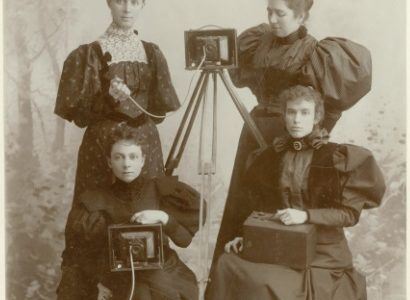This is the fourth in a series of Archives Month posts around this year's theme, North Carolina Travel, Tourism, and Vacation. It was written by Kathelene McCarty Smith, Interim Head of the Martha Blakeney Hodges Special Collections and University Archives at UNC Greensboro.
As both the resident “lady doctress” and an amateur photographer, Dr. Anna Maria Gove was a very unique faculty member of the State Normal and Industrial College (now UNC Greensboro). The University Archives has many of the earliest images of the college thanks to the lens of Dr. Gove. When she first arrived on campus in 1893 as a young physician, she had graduated from Woman’s Medical College of New York Infirmary only the previous year. She would remain at the school as physician, professor of hygiene, and director of the Department of Health until her retirement in 1937.

Figure 1. Dr. Anna Maria Gove
Born in New Hampshire and educated in the Northeast, Gove had little direct knowledge of the South. Her intellectual and cultural interest was piqued by her new North Carolina home, and apparently, the sight of a female doctor setting up practice at the State Normal also caused a great deal of curiosity. It was reported that a male physician traveled from another town just to see with his own eyes what Dr. Anna Gove actually looked like.

Figure 2. The faculty camera club, clockwise from bottom left: Anna Gove, Edith McIntyre, Mary Petty, and Melville Fort
Gove set up her office in the Brick Dormitory and began caring for sick and infirmed students during office hours, but during her leisure time, she started a faculty camera club. This adventurous group incorporated several of the female professors who would soon become her close friends, including Edith McIntyre (Professor of Domestic Science), Melville Fort (Art Professor), and Mary Petty (Chemistry Professor). Together they journeyed over hills and dales, taking photographs of the local surroundings, picnicking in neighboring fields, and capturing interesting scenes around Guilford County.
There is only one photograph of the camera club as a group, which was taken in a professional studio using a canvas backdrop (Figure 2), with members, cameras, cases, and a tripod figuring prominently. The club members’ composition in the photograph is especially interesting because the photographer who took the shot must have been aware that he/she also seemed to be the subject. The configuration causes the viewer to have the same sensation. Gove is the photographer kneeling at the front left, with an expression of eager anticipation, waiting to get her shot.

Figure 3. Edith McIntyre (Left) and Gove (Right) on a Camera Club Expedition
Images from this period survive in Gove’s manuscript collection housed at the Martha Blakeney Hodges Special Collections and University Archives at UNC Greensboro. Some are carefully marked “Fort,” presumably because they were taken by Melville Fort, another member of the club. It can be assumed that the others were all taken by Gove. Many of the photographs include campus buildings and landscapes and serve as significant illustrations of the history of the university. Other images reflect Gove’s intellectual curiosity of her surroundings, such as a traveling Wild West show where she seemed comfortable taking photographs not only from the stands, as a member of the audience, but also behind the scenes where she took pictures of cowboys and others touring with the show.
True insight to Gove’s personality may be most evident in photographs such as one from a Guilford County tobacco auction (Figure 4). Taking a close look at this photograph, it is easy to see the surprise on these men’s faces as they stop long enough for the small but gutsy photographer to capture the scene.

Figure 4. A tobacco auction in Guilford County
Whether the women became too busy teaching, or because Gove began to travel further afield for postgraduate study, personal trips, or her service during World War I, the faculty camera club apparently did not last long. Although she continued to take photographs, Gove also began to collect postcards of her extensive travels throughout North Carolina.

Figure 5. Postcards of the Carolina coast and a tobacco field
She was an avid correspondent, constantly writing to friends and relatives, but she also gathered images for her personal collection, both from North Carolina and other parts of the United States. As for her favorites from North Carolina, she seemed particularly fond of scenes of tobacco fields, the seashore, the mountains, resort hotels, and flowers that are indigenous to the state. She also collected postcards from historic sites such as the Old Mill in Salisbury, the birthplace of President Andrew Johnson in Raleigh, and Old Salem. There were even some cards that captured more colorful scenes such as mountain stills. While it is fortunate that these photographs and postcards survive, it is regrettable that, in most cases, she did not annotate the cards that she collected from the places that she visited, so we have little history of either the camera club or the context of her travels. Luckily, she did keep the postcards that others sent to her, and they can be found in her extensive manuscript collection.

Figure 6. Birthplace of President Andrew Johnson
For a closer look at her photographs and postcard collection as well as her personal papers, please see the Dr. Anna Maria Gove Papers, https://gateway.uncg.edu/islandora/object/mss%3AMSS0002?page=1. The postcards in the collection have been digitized, and her photographs are still being processed (with hopes of digitizing them after they are processed).
